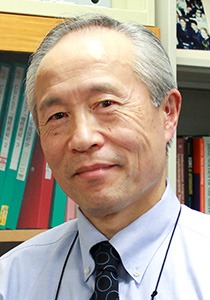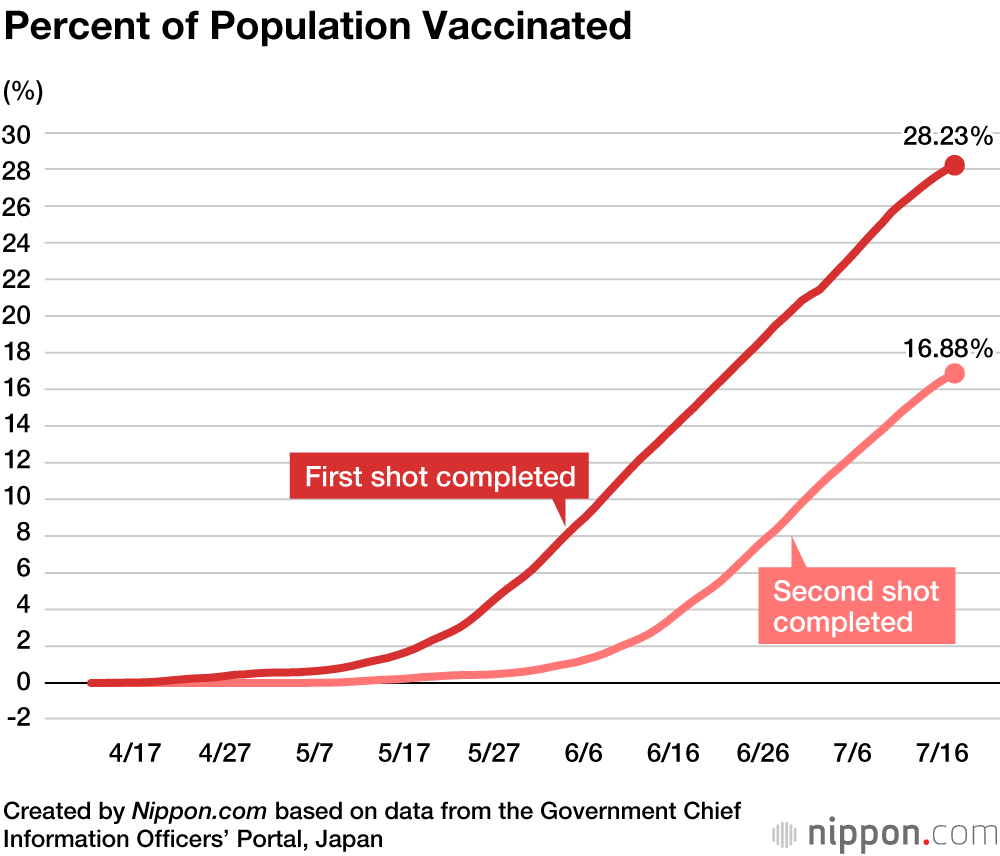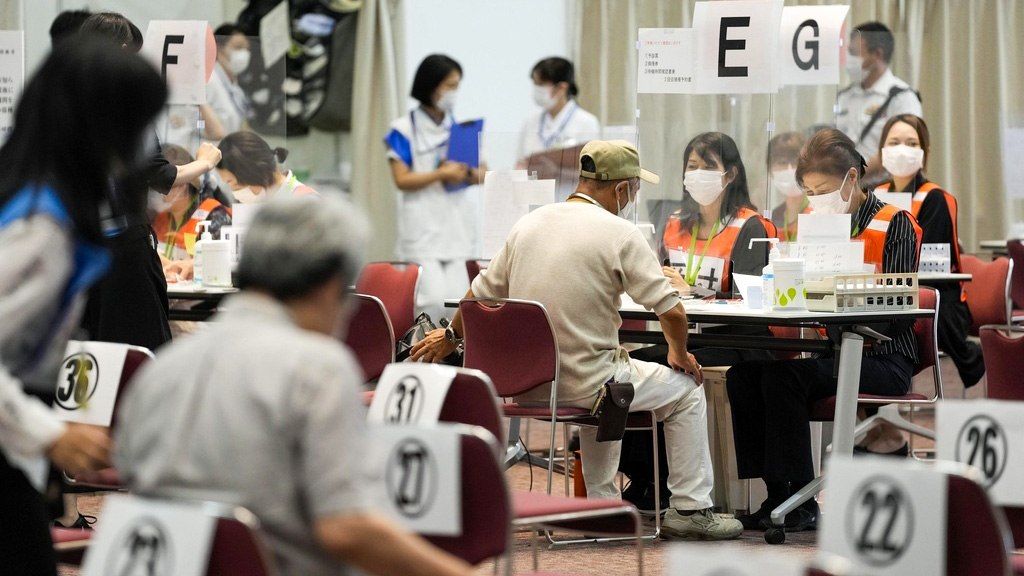
Control of the COVID-19 Pandemic “Two or Three Years” Down the Road
Science Health Society- English
- 日本語
- 简体字
- 繁體字
- Français
- Español
- العربية
- Русский
Infections Increase Despite Vaccine Progress
INTERVIEWER Tokyo is under another state of emergency as the Delta variant of the SARS-CoV-2 virus becomes ever more common. What are Delta’s characteristics?
MIYASAKA MASAYUKI It is about 1.8 to 2 times more infectious than previous COVID-19 variants. With the previous ones, we know that when one virus enters a cell, within 10 hours there will be 1,000 new viruses. Simple math tells us that when those viruses are released, they can infect up to 1,000 surrounding cells. With the Delta variant, a single virus can create 2,000 copies in the same ten hours, so 2,000 surrounding cells can be infected. In other words, with the original variant you could see 1 million copies in 20 hours, but the Delta variant takes that up to 4 million.
The pathogenicity, or ability to cause severe illness, of the individual viruses may not have changed much, but the numbers are so much larger. Resisting 2,000 attackers is much more difficult than resisting 1,000. They force their way in and overwhelm the immune system, which then leads to serious illness.
INTERVIEWER So, it’s more of a threat because it’s more infectious?
MIYASAKA We’re seeing infection spreading in groups that had been safe so far, like children. Children get lots of vaccines from a very young age, so their immune systems should be quite strong, but the virus is spreading within schools in Britain, for example. On the other hand, as people 65 and older are making good progress in getting vaccinated against COVID-19, they are seeing fewer infections, and less-severe symptoms. So, the reason we have a rise in infections despite the increase in vaccinated population is not that the vaccine is not working, but that infection rates among unvaccinated populations are increasing.
INTERVIEWER Vaccinations are lagging for populations other than the elderly, and the forties to fifties cohort is seeing an increase in severe cases.
MIYASAKA Even people in their forties and fifties, whose immune systems are weaker than those of younger people, have been able to fight off the older variants. However, the increased infectiousness of the Delta variant means that the virus increases so much in a short time that it simply overwhelms the immune system. Even with the limits on vaccinations right now, though, we should still be able to cover people in that age group with mass workplace vaccinations.
The Path to Suppression
INTERVIEWER So, are the new vaccines working?
MIYASAKA Data from Israel and elsewhere is showing that not only do the vaccines help prevent COVID-19 infection, but also suppress disease onset, and prevent advance to more serious illness. To put it another way, it’s a triple barrier that prevents infection, suppresses onset, and reduces severity. It still takes at least one month for the vaccine to take full effect. In Israel’s case, they started to see a drop in infections in two months, with a drop in severe cases first, and then a drop in overall infections. I think that if Tokyo continues vaccinating its population, it will see the same results.
INTERVIEWER The states of emergency have not been particularly effective in keeping people from going out, and seem to be reaching their limits.
MIYASAKA As we vaccinate more people, there will be less need for such behavioral changes. For example, I have attended dinner with others who have been fully vaccinated, and what I’ve been telling people lately is, if you want to have a year-end party, then get both shots. So, if we’re worrying about having to maintain the behavioral changes that have been suppressing the economy, I think this is an area where we can bring about significant changes.
INTERVIEWER The government is saying that it plans to provide vaccines to everyone who want them within the year. If it can achieve that, is there a chance of bringing the pandemic under some control?
MIYASAKA I think so. However, we won’t ever reach zero infections, and the virus will continue to spread among the unvaccinated. Our ability to return to normal life depends on vaccination progress. If we mimic Britain and make a big show of taking our masks off and celebrating, we’ll soon be right back at square one.
And no matter how low we bring infection numbers within Japanese populations, if people bring the virus in from abroad, it will start to spread again. Japan will never be able to relax unless the pandemic is suppressed globally. Current estimates say that global vaccination will take two or three years. We have to be ready for the virus to come back in from overseas during that period.
People keep asking me if they can stop wearing a mask after they get vaccinated, but it’s not quite that simple. If you get both shots, you should be OK yourself. But we still don’t know who is carrying the virus at any moment. Asymptomatic people can still spread the infection, and as people come in from overseas, the unvaccinated can become infected and spread the virus. Even if 70 percent of Japan’s population is vaccinated, that will leave 30 percent unvaccinated. With a 1 percent infection rate and a 1 percent mortality rate, that could be 3,600 lives lost a year.
Vaccine Components Depend on China
INTERVIEWER The Moderna vaccine supply is smaller than the government initially said, and people are starting to doubt whether we will get enough.
MIYASAKA The vaccine will show up eventually, so I’m not that worried. I imagine there will be times when the global situation creates some supply instability. It is inconceivable, though, that Pfizer and Moderna would break their promises regarding Japan’s supply this year.
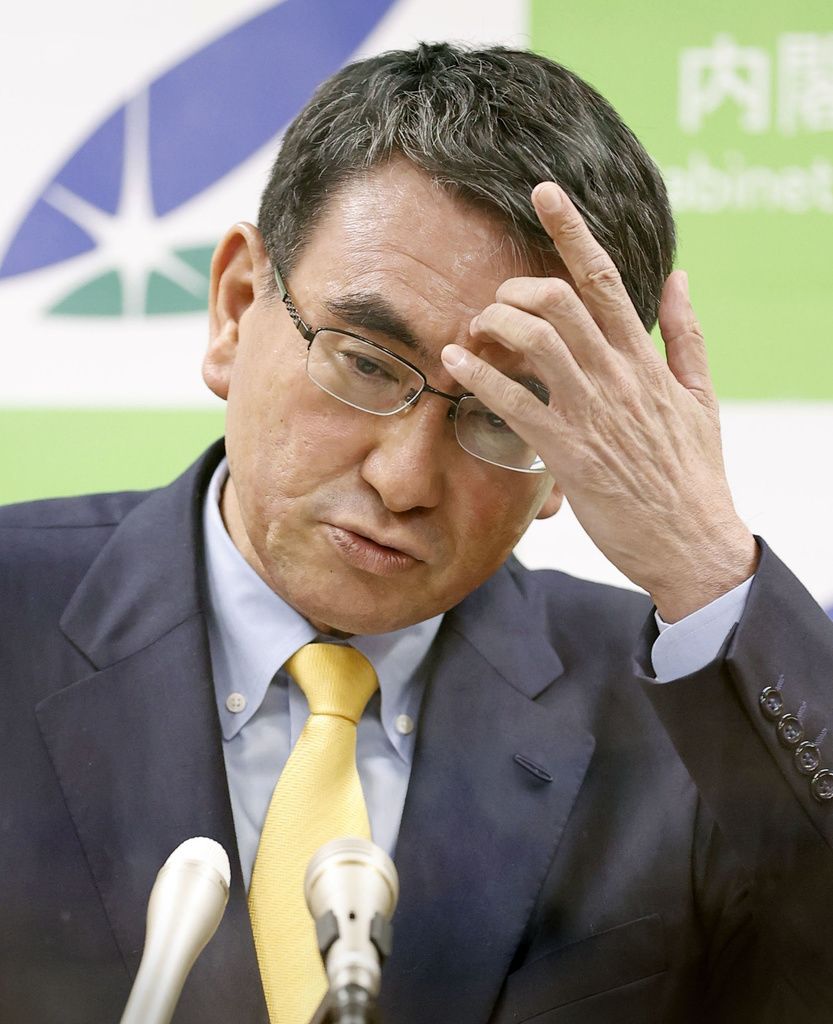
Minister for administrative reform Kōno Tarō announced a temporary halt to applications for workplace and local government mass vaccinations due to supply concerns. (© Kyōdo).
However, one underreported issue that worries me is a potential lack of raw materials to make the vaccines. These COVID-19 vaccines are called mRNA vaccines, but they aren’t actually made from RNA. They are made from DNA that has been copied by modified E. coli bacteria that can then be read as RNA. So, manufacturers need raw materials to make DNA, namely the four base proteins. China is producing those raw materials very cheaply, but if that supply dries up for some reason, global vaccine production will be in serious trouble. At one point, there was a shortage of PCR test reagents precisely because they depended on Chinese raw materials.
INTERVIEWER It sounds like Japan also needs to be able to produce its own raw vaccine materials, then.
MIYASAKA Just like with masks, if we depend on foreign sources, we’re bound to have trouble. Fortunately, Japan makes not only mRNA vaccines, but also a variety of others, including inactivated virus vaccines. If supplies of one raw material stop, then that vaccine will become unavailable, so it’s important to be able to supply your own vaccines in a variety of formats.
One Year of Immunity
INTERVIEWER How long does a double vaccination work?
MIYASAKA I think we can expect full vaccination to last for a year. Moderna and Pfizer have eight months of observation data showing that two doses of vaccine can increase neutralizing antibodies to inhibit viral infection by hundreds, even over a thousand times. Even a minimum of forty times offers a strong antiviral response. The antibody titer, a measure of a person’s antibody concentration, drops over time, but even after more than 200 days, it only drops 10 to 20 percent. Given this decay curve, some level of immunity should last well over a year. T-lymphocytes, which help B-lymphocytes to produce antibodies, also remain active for a year.
INTERVIEWER Pfizer has started talking about the need for a third shot.
MIYASAKA Pfizer’s argument is that it will bring neutralizing antibodies five to ten times higher than immediately after the second dose, and so it should be able to better resist new variants. None of that is bad, but it will also mean the side effects are that much stronger. Also, neutralizing antibodies are not the body’s only means of resisting the virus.
INTERVIEWER Will we need to be vaccinated annually?
MIYASAKA If the vaccines last for two years instead of one, then we should get boosters once every two or three years. If they last four or five, then one booster every five years will be fine, like with the pneumonia vaccine. That will also greatly reduce stress on society. I believe these vaccines will end up something like that.
Olympic Influence?
INTERVIEWER The Tokyo Olympics are upon us, and not only are there issues with quarantine, but other problems have arisen, like the bus drivers taking athletes to their venues not being vaccinated. Is there a risk of infection spreading through the city?
MIYASAKA There’s a reasonable fear of such, but it should soon subside to a certain extent. It’s terrible that the vaccine has not been given to essential workers connected to the games, like hotel workers. I imagine that alone will cause some spread, but the real problem is that Japan simply does not have sufficient quarantine practices. Even before the Olympics began, there were dozens of cases where people came from overseas and slipped right through quarantine, so the worries extend far beyond the Olympics alone. If the officials were truly worried, they should have considered making quarantine more effective in the first place.
Since the Delta variant was first detected in India, officials have been working hard to stop entry from that part of the world, but it has already spread globally. Airport inspectors are focusing on antigen and PCR tests, but the tests only catch 70 percent of the positive cases, so 30 percent pass through. The only way to boost accuracy is to do repeated tests in a short span of time.
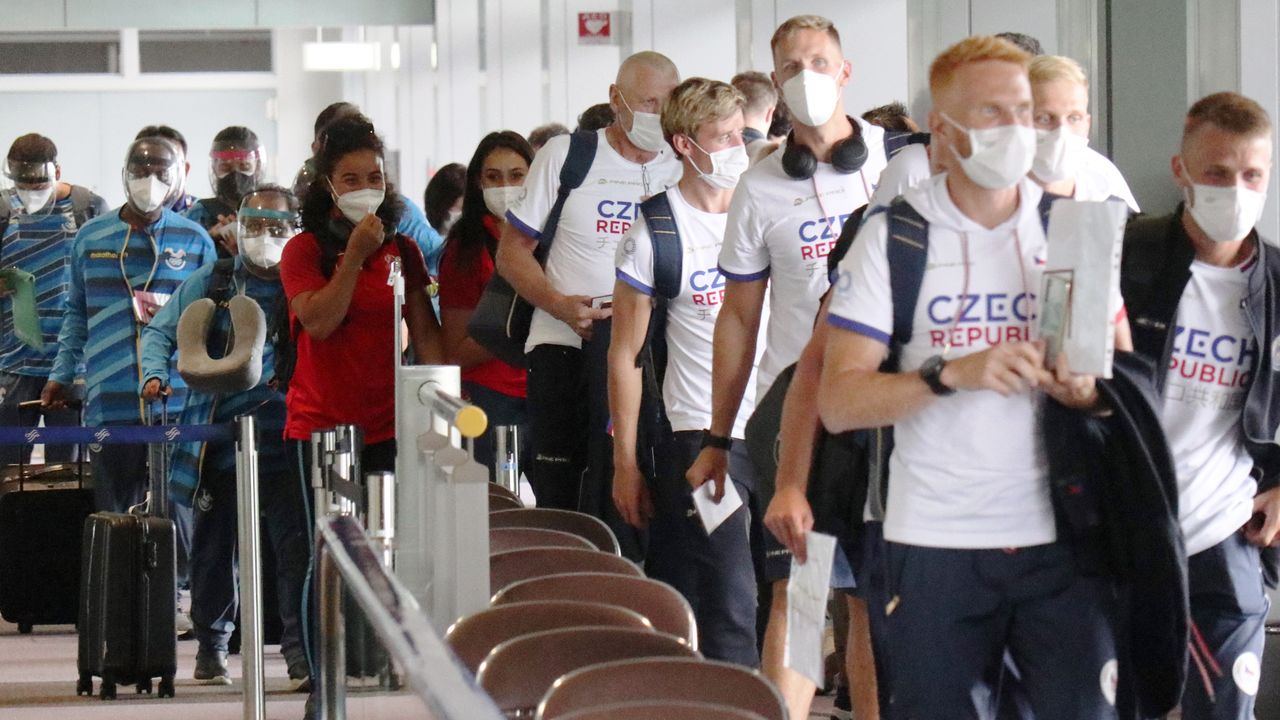
Narita Airport at the peak of the influx of Olympic athletes (© Jiji)
INTERVIEWER With people bringing in all kinds of variants from around the world, is there no chance of a kind of “virus cocktail” appearing?
MIYASAKA I think that very unlikely. This virus is different from the flu virus in that different variants and do not mix. In the case of influenza, when the swine flu mutated and passed to birds, the swine virus and bird virus hybridized, resulting in an enormous mutation. In contrast, more than 10,000 variants of the new coronavirus have appeared, but they are not chimeras (a type with a mixture of different genetic information), rather, they are unique strains that arose in different countries where the infection was particularly rampant.
It’s very rare for multiple variants to infect a single person, and when one virus does take hold, it generates interferons that resist other viruses, making it difficult for multiple viruses to infect at one time. As far as I am aware, there are almost no cases of a single individual coming down with multiple variants.
INTERVIEWER How big a risk are the Olympic games, really?
MIYASAKA I was originally quite worried about the Olympics, but I’m relieved that officials decided not to allow spectators. And it is also invaluable that they have tried hard to vaccinate the athlete groups. I think there will be a certain level of spread, but it should not go very far; nor should people end up taking the virus back to their home countries.
Root of Pandemic is Climate Change
INTERVIEWER Some have been saying that environmental destruction is a source of pandemics.
MIYASAKA The biggest source is human destruction of the natural environment, namely deforestation. AIDS is one example, with a virus that had been found in apes jumping to humans and mutating. Infectious diseases occurring in Africa, like Ebola, are all linked to deforestation.
INTERVIEW Is this because of the increased contact between people and animals?
MIYASAKA That’s right. Global warming has also contributed to the issue, making it easier for infections to spread. However, one thing that I do want people to keep clear is that even though bacteria can spread in any number of hot and humid places, viruses can only multiply inside a cell. Global warming will not influence viral infection as much as bacterial illnesses.
INTERVIEW Where and how do you think the next virus will appear?
MIYASAKA About two years before COVID-19, a US researcher predicted that a pandemic was all but inevitable. The prediction said it would be caused by an RNA virus because of their high infectivity, low virulence, and high mutability. This was spot on. These diseases do not cause severe symptoms at first, so the infected person stays active and spreads the disease, which helps lead to a pandemic. As the virus mutates, the immune system struggles to keep up, and infection spreads further. We might get this pandemic under control in two or three years, but the next pandemic will most likely be another RNA virus.
(Originally published in Japanese on July 20, 2021. Banner photo: Patients being processed at a mass COVID-19 vaccination center in Osaka. © Kyōdō.)
Olympics vaccine infectious disease vaccination COVID-19 pandemic Kōno Tarō
